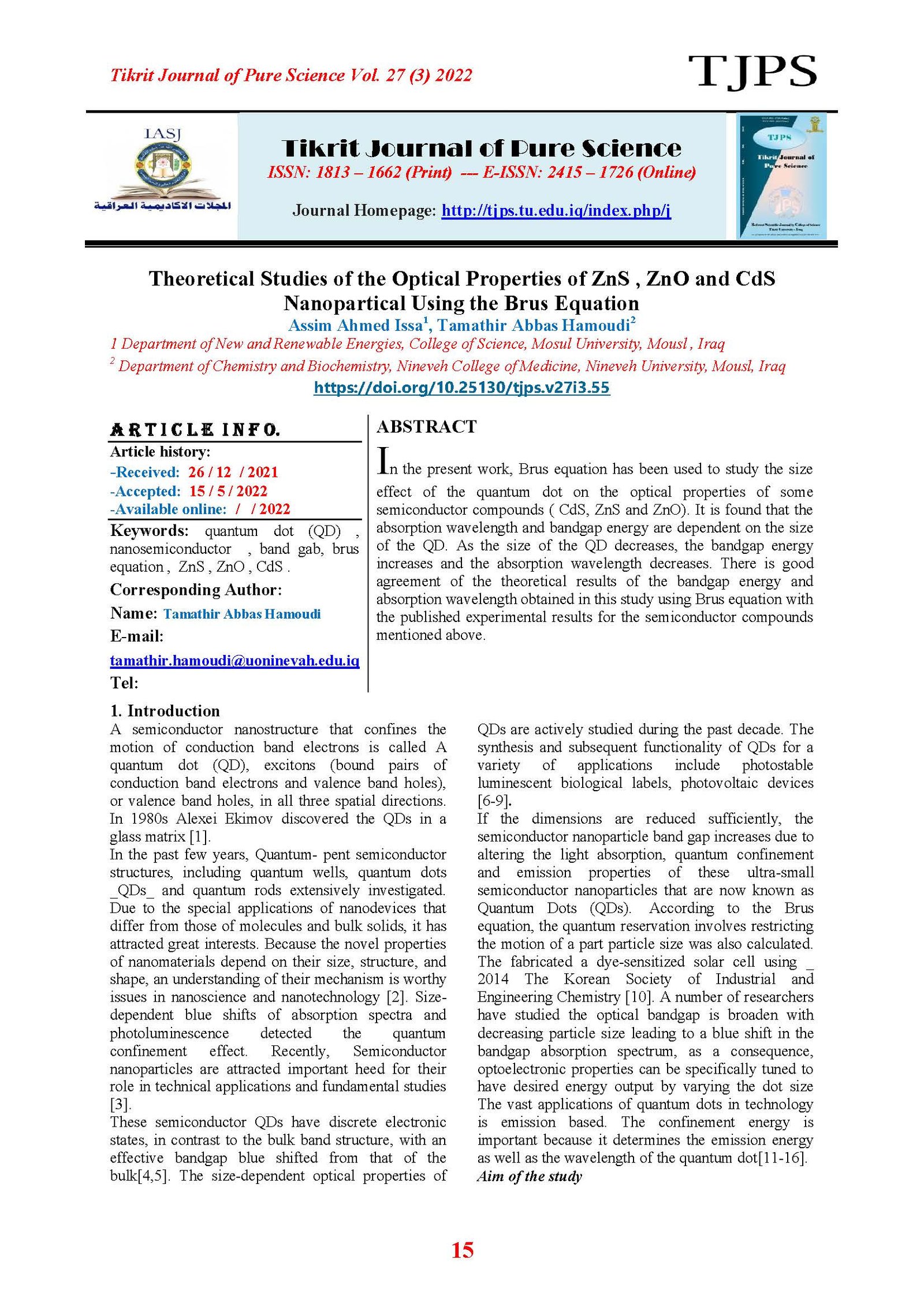Theoretical Studies of the Optical Properties of ZnS , ZnO and CdS Nanopartical Using the Brus Equation
Main Article Content
Abstract
In the present work, Brus equation has been used to study the size effect of the quantum dot on the optical properties of some semiconductor compounds ( CdS, ZnS and ZnO). It is found that the absorption wavelength and bandgap energy are dependent on the size of the QD. As the size of the QD decreases, the bandgap energy increases and the absorption wavelength decreases. There is good agreement of the theoretical results of the bandgap energy and absorption wavelength obtained in this study using Brus equation with the published experimental results for the semiconductor compounds mentioned above.
Article Details

This work is licensed under a Creative Commons Attribution 4.0 International License.
Tikrit Journal of Pure Science is licensed under the Creative Commons Attribution 4.0 International License, which allows users to copy, create extracts, abstracts, and new works from the article, alter and revise the article, and make commercial use of the article (including reuse and/or resale of the article by commercial entities), provided the user gives appropriate credit (with a link to the formal publication through the relevant DOI), provides a link to the license, indicates if changes were made, and the licensor is not represented as endorsing the use made of the work. The authors hold the copyright for their published work on the Tikrit J. Pure Sci. website, while Tikrit J. Pure Sci. is responsible for appreciate citation of their work, which is released under CC-BY-4.0, enabling the unrestricted use, distribution, and reproduction of an article in any medium, provided that the original work is properly cited.
References
[1] Surana, K., Singh, PK., Rhee H-W., 2014, Bhattacharya BJJoI, Chemistry E. 20(6) Synthesis, characterization and application of CdSe quantum dots. ; 4188-93.
[2] Raj, S., Yun, JH., Adilbish G., Ch, RK.,2015, Formation of core@ multi-shell CdSe@ CdZnS–ZnS quantum dot heterostructure films by pulse electrophoresis deposition. ;83,pp618-26.
[3] Lin, K-F., Cheng, H-M., Hsu ,H-C., Lin, L-J.,2005, Hsieh W-FJCPL. Band gap variation of size-controlled ZnO quantum dots synthesized by sol–gel method. 409(4-6):pp208-11.
[4] Djurišić, AB., Leung, YHJs.,2006, Optical properties of ZnO nanostructures. 2(8‐9):pp944-61.
[5] Chen, R., Tran ,T-TD., Ng, KW., Ko ,WS., Chuang, LC., 2011 Nanolasers grown on silicon. 5(3):170.
[6] Arakawa,Y., Nakamura, T., Urino, Y., 2013 Fujita TJICM. Silicon photonics for next generation system integration platform. 51(3):pp72-7.
[7] Ning C-ZJpss. Semiconductor nanolasers. 2010;247(4):774-88.
[8] Song, Q., Cao, H., Ho, S-T., 2009 ,Solomon GJAPL. Near-IR subwavelength microdisk lasers. 2009;94(6):061109.
[9] Chena, L-Y., Chou, H-L., Chenc, C-H., Tseng, C-H.,2012, Surface modification of CdSe and CdS quantum dots-experimental and density function
theory investigation. Nanocrystals-Synthesis, Characterization and Applications: IntechOpen.
[10] Shortell, MP., 2014Zinc oxide quantum dot nanostructures: Queensland University of Technology.
11.Fernando, RM., Juan, C F., José, A., David, V., and Susana ,F.,2020. Crystals , 10 pp 1-17.
[12] Roaa, Sh., Hammadand1., Nidhal M., Abdul-Ameer.2021, Ibn Al-Haitham International Conference for Pure and Applied Sciences (IHICPS) 1879 ,032078. The influence of temperature and size on the absorption coefficient of CdSe quantum dots,pp1-7.
[13] Reyhaneh, T., Xingjian, Z., Joshua C., Alexander, M., and Allison, M D. 2021. Chem. Mater., 33, Correlating ZnSe Quantum Dot Absorption with Particle Size and Concentration ,pp7527−7536.
[14] Alexander, L.,and Louis, E B. 2021 ACS Nano15, Nanocrystal Quantum Dots: From Discovery toModern Development,pp 6192−6210.
[15] Ikeri,HI., Onyia, AI., Onuabuchi VC. 2021, International Journal of Engineering and Applied Sciences (IJEAS) ISSN: 2394-3661, Volume-8, Issue-7, Bandgap Engineering of the II-IV, III–V and IV–VI Semiconductor Quantum Dots for Technological Applications,pp1-6.
[16] Harry, ST., Adekanmbi MA ., 2020,International Journal of Research-GRANTHAALAYAH , Vol 8(11), CONFINEMENT ENERGY OF QUANTUM DOTS AND THE BRUS EQUATION, pp 318 – 323
[17] Kippeny, T., Swafford, LA., 2002,Rosenthal SJJJoCE. Semiconductor nanocrystals: a powerful visual aid for introducing the particle in a box. 79(9):1094.
[18] Brus,1986 LJTJoPC. Electronic wave functions in semiconductor clusters: experiment and theory. 1986;90(12):pp2555-60.
[19] Chukwuocha EO, Onyeaju MC, Harry TSJWJoCMP. Theoretical studies on the effect of confinement on quantum dots using the brus equation. 2012;2(02):96.
[20] Bacaksız, C.,2011 Excitonic luminescence in spherical core-multi-shell quantum dot structures: Izmir Institute of Technology.
[21] Kumbhojkar, N., Nikesh, V., Kshirsagar ,A.,2000, Mahamuni SJJoAP. Photophysical properties of ZnS nanoclusters. 88(11):pp 6260-4.
[22] Baskoutas, S., 2006,Terzis AFJJoap. Size-dependent band gap of colloidal quantum dots. .99(1):013708.
[23] Ekpekpo, A., 2013 Akpojivi LJJoETiE, Sciences A. Synthesis and characterization of CdS and CdSe quantum dots by uv-vis spectroscopy. 4(2):pp273-80.
